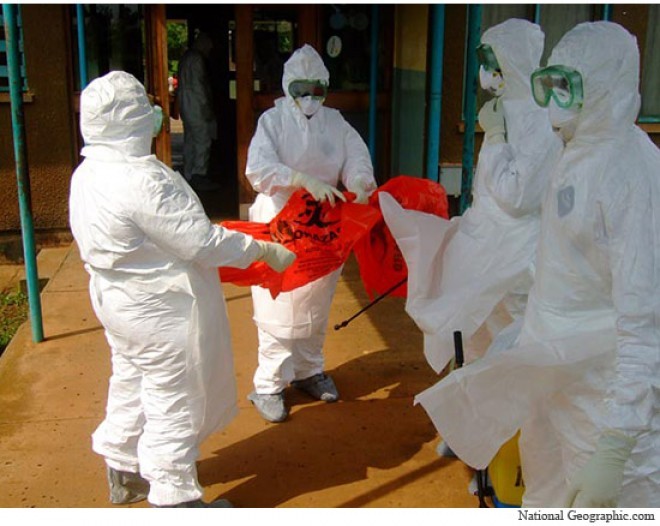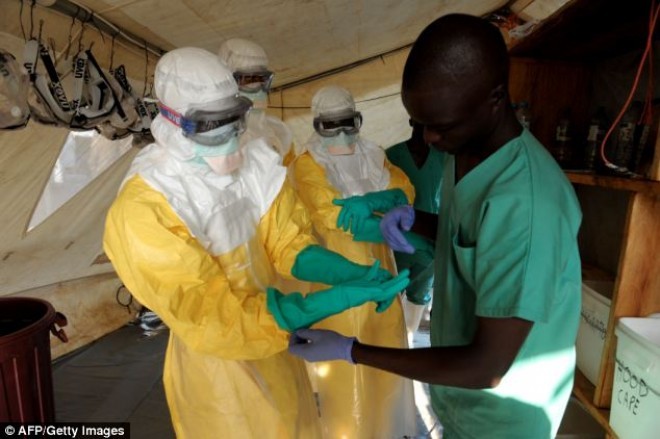
One of the most feared, yet least discussed topics among the mainstream media is the possibility of Ebola being spread through the air – something the World Health Organization is currently vehemently denying. However thanks to some digging from our friend Glenn Canaday, yournewswire.com can exclusively confirm that the government run Public Health Agency of Canada, Ebola, in fact CAN be spread via the air.
According to the report on The Public Health Agency of Canada’s official website, “Humans may be infected by handling sick or dead non-human primates and are also at risk when handling the bodies of deceased humans in preparation for funerals, suggesting possible transmission through aerosol droplets.”

BYPASS THE CENSORS
Sign up to get unfiltered news delivered straight to your inbox.
You can unsubscribe any time. By subscribing you agree to our Terms of Use
Latest Video
They go on to say, “In the laboratory, infection through small-particle aerosols has been demonstrated in primates, and airborne spread among humans is strongly suspected.”
The airborne nature of Ebola is something that is concerning many, yet facts are scarce. However in “Zoonoses and Communicable Diseases Common to Man and Animals” (3rd ed., pp. 142-145) by P.N Ancha. & B. Szyfres of Washington D.C.: Pan American Health Organization, an article from Journal of Nippon Medical School entitled, “Ebola hemorrhagic fever (EHF): mechanism of transmission and pathogenicity”, and even “The Journal of Infectious Diseases” all strongly support that Ebola, in fact, can be transmitted through the air.
What does this all mean for the rest of us? Well, The Public Health Agency in their report go on to mention, the airborne transmission for humans has “not yet been conclusively demonstrated”, that is because they would need to purposely infect people with the virus.
This now strong possibility of Ebola potentially being airborne could spell horror for much of the world. The World Health Organization maintain an official stance that Ebola is not transmitted by air, however other world government health organizations say otherwise. Just seven days ago, The World Health Organization stated, “The World Health Organization’s director said today that the ever-worsening Ebola outbreak is ‘moving faster than our efforts to control it.’ The results could be catastrophic, and there is a “high risk” the outbreak will spread beyond West Africa, where the death toll recently hit 729.”
We now know, only barely a week later, that Ebola is being found in Saudi Arabia, and people in NYC and Canada are being tested – is The World Health Organization’s “worst fear” materializing?
Through some intensive digging, in the CDC’s official research manual on Ebola, they state something rather startling, “Ebola-Reston appeared in a primate research facility in Virginia, where it may have been transmitted from monkey to monkey through the air. While all Ebola virus species have displayed the ability to be spread through airborne particles (aerosols) under research conditions, this type of spread has not been documented among humans in a real-world setting, such as a hospital or household.”
The CDC explains airborne spreading by saying, “In this type of transmission, infective agents are spread as aerosols, and usually enter a person through the respiratory tract. Aerosols are tiny particles, consisting in part or completely of the infectious agent itself, which become suspended in the air. These particles may remain suspended in the air for long periods of time, and some retain their ability to cause disease, while others degenerate due to the effects of sunlight, dryness or other conditions. When a person breathes in these particles, they become infected with the agent—especially in the alveoli of the lungs. (see also “aerosolization”)
Small particles of many different sizes contaminated with the infective agent may rise up from soil, clothes, bedding or floors when these are moved, cleaned or blown by wind. These dust particles may be fungal spores— infective agents themselves—tiny bits of infected feces, or tiny particles of dirt or soil that have been contaminated with the agent.
Droplet nuclei can remain in the air for a long time. Droplet nuclei are usually the small residues that appear when fluid emitted from an infected host evaporates. In the case of the virus causing hantavirus pulmonary syndrome, the rodent carriers produce urine. The act of spraying the urine may create the aerosols directly, or the virus particles may rise into the air as the urine evaporates. In other situations, the droplets may occur as an unintended result of mechanical or work processes or atomization by heating, cooling, or venting systems in microbiology laboratories, autopsy rooms, slaughterhouses or elsewhere.
Both kinds of particles are very tiny. Larger droplets or objects that may be sprayed or blown but that immediately settle down on something rather than remaining suspended, are not considered to belong to the airborne transmission mechanism. Such sprays are considered direct transmission.”
While the former CDC quotes aren’t directly discussing this outbreak, it is VERY interesting to note that that information was in the manual EXPLAINING Ebola.
Even scarier, an article from 2012 from healthmap.org, in discussing Ebola, says, discussing new research in 2012, “When news broke that the Ebola virus had resurfaced in Uganda, investigators in Canada were making headlines of their own with research indicating the deadly virus may spread between species, through the air.”
The article goes on to say, “While the study provided evidence that transmission of Ebola between species is possible, researchers still cannot say for certain how that transmission actually occurred. There are three likely candidates for the route of transmission: airborne, droplet, or fomites.
Airborne and droplet transmission both technically travel through the air to infect others; the difference lies in the size of the infective particles. Smaller droplets persist in the air longer and are able to travel farther- these droplets are truly “airborne.” Larger droplets can neither travel as far nor persist for very long. Fomites are inanimate objects that can transmit disease if they are contaminated with infectious agents. In this study, a monkey’s cage could have been contaminated when workers were cleaning a nearby pig cage. If the monkey touched the contaminated cage surface and then its mouth or eyes, it could have been infected.”
A Nature.com article about the recent study, they say, “While primates develop systemic infection associated with immune dysregulation resulting in severe hemorrhagic fever, the EBOV infection in swine affects mainly respiratory tract, implicating a potential for airborne transmission of ZEBOV”
The study goes on to explain, “Under conditions of the current study, transmission of ZEBOV could have occurred either by inhalation (of aerosol or larger droplets), and/or droplet inoculation of eyes and mucosal surfaces and/or by fomites due to droplets generated during the cleaning of the room. Infection of all four macaques in an environment, preventing direct contact between the two species and between the macaques themselves, supports the concept of airborne transmission.”
Even scarier, they say, “Our findings support the hypothesis that airborne transmission may contribute to ZEBOV spread, specifically from pigs to primates, and may need to be considered in assessing transmission from animals to humans in general.”
An excerpt from a recent article regarding a warning sent to airlines by the CDC confirms that the US government is, in fact, VERY concerned about Ebola being airborne, “A CDC advisory entitled Interim Guidance about Ebola Virus Infection for Airline Flight Crews, Cleaning Personnel, and Cargo Personnel reveals that the federal agency is concerned about airborne contamination.
The advisory urges airline staff to provide surgical masks to potential Ebola victims in order “to reduce the number of droplets expelled into the air by talking, sneezing, or coughing.” (emphasis mine).
The CDC is also directing airline cleaning personnel to, “not use compressed air, which might spread infectious material through the air.”
So why is the World Health Organization denying so fervently that Ebola is not airborne? With many scientific studies to back up this horrifying potential, people must keep an eye on what is really going on with this virus. Because, hype or not, this virus is deadly and has the potential to impact life on Earth in a major way.
Sources and links:
http://www.nature.com/srep/2012/121115/srep00811/full/srep00811.html
http://healthmap.org/site/diseasedaily/article/pigs-monkeys-ebola-goes-airborne-112112
http://www.cdc.gov/vhf/ebola/pdf/fact-sheet.pdf
http://www.phac-aspc.gc.ca/lab-bio/res/psds-ftss/ebola-eng.php#note28




